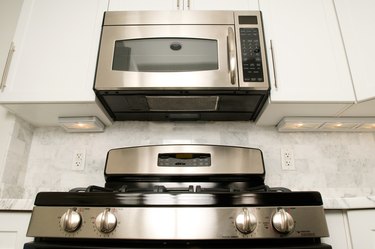
Poached eggs are among the simplest and most delicate of all egg preparations. Nothing could be simpler, in theory: Crack an egg, slide it into gently simmering water and wait as it coagulates. In practice, the egg might dissipate into the water, leaving the yolk surrounded by a spongy veil of watery whites. Some cooks prefer to poach their eggs in a cup instead, either in a pot of simmering water or in a microwave egg poacher.
Conventional vs. Microwave Poaching
Video of the Day
Conventional poaching requires a pot deep enough for the egg to begin coagulating before it hits bottom. Otherwise, it might stick to the pan and come apart when the cook tries to retrieve it. The very freshest of eggs hold together well in the water, but older eggs often poach poorly and fill the water with loose strands and clouds of egg white. Cooks who object to the random and untidy appearance of conventional poached eggs often prefer microwave poaching, which creates a uniformly round appearance and requires less time.
Video of the Day
Preparing to Poach
Before you use the microwave poacher, wash it thoroughly in warm, soapy water. Rinse and dry it well. Unless the instructions tell you otherwise, spray the cups with nonstick pan spray, or grease them lightly with butter, oil or shortening. Crack an egg into each of the cavities of the poacher. Use a fork to prick the yolk at least once and the whites several times, which will allow steam to vent and prevent the egg from exploding as it cooks. Spoon a teaspoon of water over each egg to create steam, which helps cook the egg and keep it soft.
Poaching
Close the poacher's lid or snap it onto the base, depending on the design. Place it in your microwave and set your power level to medium. Microwaves vary widely in power, from 600 watts for a basic model to 1,200 watts in many higher-end models. Cooking time will vary with the power of the microwave, taking as little as 50 seconds for two eggs at 1,200 watts, according to the instructions packaged with one major brand. Once it's done, open the poacher briefly to check the eggs, then return it to the microwave for 10 seconds at a time if they're not quite finished.
Finish
Once the egg has set, leave it in the poacher for 30 seconds while the egg's internal temperature evens out. It usually takes a few mornings of trial and error to determine the exact timing for your specific microwave, but eventually you should be able to produce eggs at the degree of doneness you prefer. Slide the eggs from the poacher to your plate or toast to serve. After each use, hand-wash your poacher carefully with soap and water before returning it to storage.